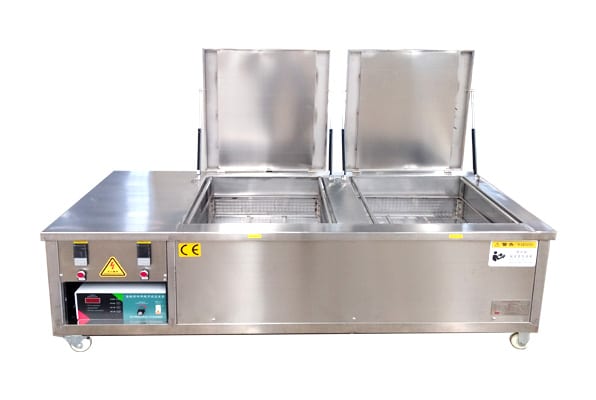Ultrasonic cleaners https://8ruiyan.com/en/all-vacuum-cleaning-furnaces/ utilize cavitation effects (microbubble implosions generating extreme pressure/temperature) to achieve thorough, non-contact cleaning of complex components across medical, electronics, manufacturing, and energy sectors, balancing high efficiency with material compatibility challenges.
In modern factories, countless metal parts, precision instruments, and electronic components undergo a silent cleaning revolution daily—immersed in liquid, activated with a button, emerging spotless within minutes. The magician behind this is the industrial ultrasonic cleaners.

I. The Silent Cleaning Storm: Demystifying the Working Principle
The core secret of ultrasonic cleaning lies in the physical phenomenon of “cavitation effect.” When an industrial ultrasonic cleaner activates, its ultrasonic generator produces high-frequency electrical signals (20kHz to 80kHz), converted into mechanical vibrations by transducers. These vibrations propagate through the cleaning solution, generating countless microscopic bubbles (50-500 μm). Under acoustic pressure, these bubbles rapidly form and violently collapse, each implosion releasing shockwaves equivalent to thousands of atmospheres and localized high temperatures—acting like microscopic bombs that blast contaminants like grease, debris, and oxides off surfaces.
Two auxiliary forces enhance the process:
- Acoustic streaming: Ultrasound drives fluid micro-currents that penetrate fine crevices
- Acceleration: High-frequency vibrations impart kinetic energy to liquid particles
When combined with suitable chemical cleaning agents, this forms a complete industrial-grade cleaning solution.
II. Core Components of Industrial Cleaning Systems
An industrial ultrasonic cleaner operates like a precision orchestra, with each component playing a vital role:
| Component | Function | Industrial-Grade Features |
|---|---|---|
| Ultrasonic Generator | Produces high-frequency signals | Adjustable frequency (20-80kHz) for diverse applications |
| Transducer | Converts electrical signals to vibrations | PZT piezoelectric ceramic, 70-90% energy efficiency |
| Cleaning Tank | Holds solution and workpieces | Corrosion-resistant reinforced stainless steel |
| Heating System | Heats cleaning solution | ±1°C temperature control precision |
| Control Panel | Adjusts parameters | Programmable multi-stage cleaning cycles |
III. Industrial Applications: Versatility in Action
- Medical Sterilization: Surgical tools and endoscopes achieve 40% higher sterilization compliance by removing biofilms from lumens
- Electronics Manufacturing: PCBs cleaned in 3 minutes without damaging 0.1mm-spaced microcomponents
- Food Safety: Beverage filling valves show <0.01mg/cm² oil residue after 65°C ultrasonic treatment
- Precision Mechanics: Complete carbon removal from micron-scale fuel injector nozzles restores spray performance
- Energy & Optics: 99.2% contaminant removal from solar panels restores original light transmission
IV. Advantages vs. Challenges: The Industrial Reality
Key Advantages:
- 3D dead-angle-free cleaning: Reaches internal gearbox crevices beyond spray systems
- Non-contact processing: Preserves gold plating on antique clock components
- Efficiency revolution: Cleans 200 bearings in 15 minutes—20× faster than manual
- Eco-efficiency: Water-based processes reduce chemical consumption by 30%
Practical Challenges:
- Material limitations: Soft rubber erodes under cavitation; carbon composites require frequency reduction
- Stubborn contaminants: Sintered oxides need acidic additives
- Cost factors: High-end units exceed $100k; transducer repairs cost ~20% of machine value
- Environmental constraints: Organic solvents require VOC treatment systems
- Noise pollution: 80dB operation demands soundproofed facilities
V. Cleaning Chemistry: The Essential Partner
Ultrasonic physics requires synergistic chemistry for peak performance. Industrial solutions include:
- Aqueous-based agents: Eco-friendly but slow-drying—ideal for conveyorized drying
- Organic solvents: Powerful against heavy grease but require explosion-proof facilities
- Enzymatic formulas: Essential for protein-based bio-contaminants in medical cleaning
- Hybrid solutions: Emerging trend combining surfactants, chelators, and corrosion inhibitors
Cutting-edge research focuses on nano-enhanced cleaners where silica nanoparticles boost cavitation intensity by 2.3×.
VI. Selection Guide: Matching Industrial Needs
- Frequency/power pairing: Engine castings need 28kHz/2000W systems; semiconductor wafers require 80kHz precision
- Tank sizing: Allow 30% beyond largest workpiece for bubble activity
- Automation integration: Automotive lines prioritize gantry systems with robotics
- Supplier evaluation: Verify acoustic field mapping services
- Lifecycle costing: Calculate 3-year energy/consumable expenses to avoid “low purchase, high upkeep”
VII. Future Frontiers: The Next Evolution
While laser cleaning emerges, ultrasonic technology advances through:
- High-frequency focused ultrasound (200kHz-1MHz) for nanoparticle removal on wafers
- Vacuum ultrasonic technology cleaning porous materials
- AI intelligent systems adjusting parameters via turbidity sensors, cutting energy use by 25%
The true value of industrial ultrasonic cleaners extends beyond cleanliness—they ensure surgical instrument sterility, protect chip manufacturing yields, and extend precision machinery lifespan. As silent warriors in industrial cleaning, they continue evolving to deliver smarter, more efficient power for modern manufacturing.
For further consultation, please contact our technical team for expert advice.
Whatsapp:86-19106101570
wechat:86-19106101570
email:nieyili@cnryan.com
